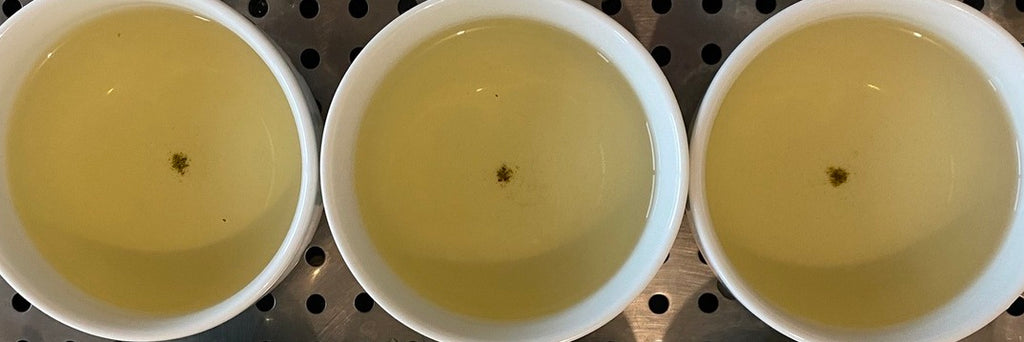News

Alishan High Mountain Oolong Summer 2023
We are excited to present a fine batch of Alishan High Mountain Oolong Tea — summer 2023! Taiwan has had much better weather during the second flush growing season, following drought conditions in early spring. And the weather during summer harvest has been auspiciously sunny!

High Mountain Oolong Summer/Fall Harvests 2022 | Eco-Cha Teas
Taiwan High Mountain Oolong Teas are typically harvested 3 or 4 times a year. Between the most popular spring and winter harvests, there are usually summer and/or fall crops. In recent years, we've been dedicated to sourcing these "in between" harvests as much as possible. We do this for two reasons.

Shan Lin Xi High Mountain Oolong Summer 2022 | Eco-Cha Teas
We had ideal weather conditions for the summer harvest of Shan Lin Xi High Mountain Oolong, following a growing season that was conducive to uniform new leaf growth on the tea bushes. The previous spring growing season was unusual in that it remained cool through May! So the spring crop was slow growing and somewhat similar to a typical winter growing season, although we had sufficient rainfall.

Alishan High Mountain Jin Xuan Oolong Summer 2022 | Eco-Cha Teas
Our summer 2022 batch of Alishan High Mountain Jin Xuan Oolong is an exemplary representative of this category of Taiwan Tea! It is lightly oxidized, offering pronounced milky/buttery notes which the Jin Xuan cultivar is famous for. Given the weather patterns through the early spring growing season compared with the late spring growing season — the second flush offers a more classic Alishan Jin Xuan flavor profile.

Shan Lin Xi Taiwan High Mountain Oolong Tea Spring 2022 | Eco-Cha Teas
Spring 2022 Taiwan high mountain tea harvest is slowly but steadily working its way up the mountain! Lower and mid-elevations were harvested by mid-April. Alishan High Mountain Oolong was mostly harvested by the last week in April, as Shan Lin Xi High Mountain Tea picking began.

Taiwan High Mountain Tea Overview Winter 2021 | Eco-Cha Teas
We taste tested our three new batches of winter High Mountain Oolong Tea -- Shan Lin Xi, Alishan, and Li Shan. We can see the difference in the oxidation levels of the tea leaves in the coloration of the brewed tea. We can see a higher degree of oxidation in the Shan Lin Xi and less oxidation as we move to the Li Shan.

Shan Lin Xi High Mountain Oolong Summer Harvest
We brewed our spring batch of Shan Lin Xi High Mountain Oolong Tea alongside the freshly picked summer batch to observe the differences between these two consecutive harvests from the same source. These two batches exhibited the classic seasonal traits of spring and summer high mountain tea.

Alishan High Mountain Oolong Summer Harvest (2021)
Spring is classically the best quality stock of any given year. So it is no surprise at all that it is more flavorful than the summer crop. This is as it should be, given that it costs almost twice as much. So in the end, the value of summer tea wins vs. its cost. It is a prime quality High Mountain Tea from a source we have come to rely on almost solely for our Alishan High Mountain Oolong. And the price is hard to beat. So if you are looking for an everyday drinker that is really quite good quality, this batch is for you!

Spring 2021 Traditional Dong Ding Oolong Making
Our friend chose to only use one pot, or tumble heater, for the fixing stage. This would make it a slower and more relaxed tea making session, while allowing the leaves that were picked later in the day to oxidize more — resulting in a more uniformly cured batch of tea.

Tea Farmers Receive Subsidies For Drought In Taiwan
The Chairman of Taiwan's Department of Agriculture made an appearance in our neighborhood (Zhushan) to conduct a field survey of the impact drought conditions have made on crops of spring tea. The Tea Research and Extension Station reported that yield is down 30-50% from average at lower elevations, and higher elevations are not much better.

Alishan High Mountain Tea Winter Harvest
We took this photo last spring when we slept out at this spot in order to catch the early morning harvest. It gives you a sense of the environment and the extent of farm development in this area of the Alishan High Mountain Tea producing region. It is one of the reasons we've chosen this farm as our source. This area was already developed as a rural farming community before the onset of modern tea production in Taiwan. The family farms were simply repurposed to grow tea when High Mountain Tea became popular. So, the development of tea production in this area has had less environmental impact than most other High Mountain Tea producing regions in Taiwan.

Comparing Seasonal Batches Of Loose Leaf Oolong Tea
The inspiration for this post began when we first tasted our spring batches of tea this year. Especially for the three teas that we'll take a look at here, we immediately thought upon tasting each of them, they are noticeably different from last winter's batch. So first, let's list the main points to observe in comparing seasonal batches from the same source of tea.
- 1
- 2

